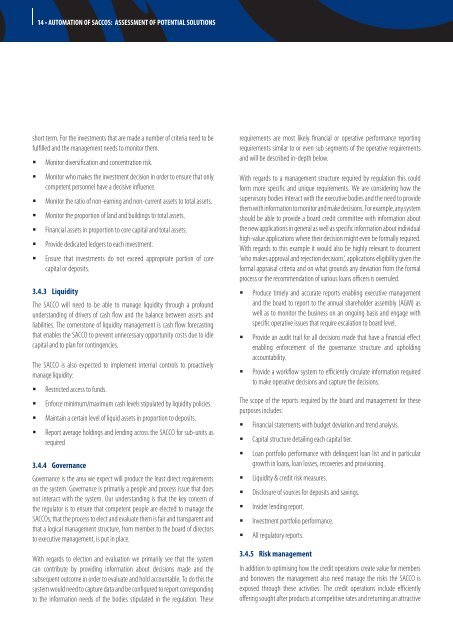Automation of SACCOs - FSD Kenya
Automation of SACCOs - FSD Kenya
Automation of SACCOs - FSD Kenya
You also want an ePaper? Increase the reach of your titles
YUMPU automatically turns print PDFs into web optimized ePapers that Google loves.
14 • AUTOMATION OF SACCOS: ASSESSMENT OF POTENTIAL SOLUTIONS<br />
short term. For the investments that are made a number <strong>of</strong> criteria need to be<br />
fulfilled and the management needs to monitor them.<br />
Monitor diversification and concentration risk.<br />
Monitor who makes the investment decision in order to ensure that only<br />
competent personnel have a decisive influence.<br />
Monitor the ratio <strong>of</strong> non-earning and non-current assets to total assets.<br />
Monitor the proportion <strong>of</strong> land and buildings to total assets.<br />
Financial assets in proportion to core capital and total assets.<br />
Provide dedicated ledgers to each investment.<br />
Ensure that investments do not exceed appropriate portion <strong>of</strong> core<br />
capital or deposits.<br />
3.4.3 Liquidity<br />
The SACCO will need to be able to manage liquidity through a pr<strong>of</strong>ound<br />
understanding <strong>of</strong> drivers <strong>of</strong> cash flow and the balance between assets and<br />
liabilities. The cornerstone <strong>of</strong> liquidity management is cash flow forecasting<br />
that enables the SACCO to prevent unnecessary opportunity costs due to idle<br />
capital and to plan for contingencies.<br />
The SACCO is also expected to implement internal controls to proactively<br />
manage liquidity:<br />
Restricted access to funds.<br />
Enforce minimum/maximum cash levels stipulated by liquidity policies.<br />
Maintain a certain level <strong>of</strong> liquid assets in proportion to deposits.<br />
Report average holdings and lending across the SACCO for sub-units as<br />
required<br />
3.4.4 Governance<br />
Governance is the area we expect will produce the least direct requirements<br />
on the system. Governance is primarily a people and process issue that does<br />
not interact with the system. Our understanding is that the key concern <strong>of</strong><br />
the regulator is to ensure that competent people are elected to manage the<br />
<strong>SACCOs</strong>, that the process to elect and evaluate them is fair and transparent and<br />
that a logical management structure, from member to the board <strong>of</strong> directors<br />
to executive management, is put in place.<br />
With regards to election and evaluation we primarily see that the system<br />
can contribute by providing information about decisions made and the<br />
subsequent outcome in order to evaluate and hold accountable. To do this the<br />
system would need to capture data and be configured to report corresponding<br />
to the information needs <strong>of</strong> the bodies stipulated in the regulation. These<br />
requirements are most likely financial or operative performance reporting<br />
requirements similar to or even sub segments <strong>of</strong> the operative requirements<br />
and will be described in-depth below.<br />
With regards to a management structure required by regulation this could<br />
form more specific and unique requirements. We are considering how the<br />
supervisory bodies interact with the executive bodies and the need to provide<br />
them with information to monitor and make decisions. For example, any system<br />
should be able to provide a board credit committee with information about<br />
the new applications in general as well as specific information about individual<br />
high-value applications where their decision might even be formally required.<br />
With regards to this example it would also be highly relevant to document<br />
‘who makes approval and rejection decisions’, applications eligibility given the<br />
formal appraisal criteria and on what grounds any deviation from the formal<br />
process or the recommendation <strong>of</strong> various loans <strong>of</strong>ficers is overruled.<br />
Produce timely and accurate reports enabling executive management<br />
and the board to report to the annual shareholder assembly (AGM) as<br />
well as to monitor the business on an ongoing basis and engage with<br />
specific operative issues that require escalation to board level.<br />
Provide an audit trail for all decisions made that have a financial effect<br />
enabling enforcement <strong>of</strong> the governance structure and upholding<br />
accountability.<br />
Provide a workflow system to efficiently circulate information required<br />
to make operative decisions and capture the decisions.<br />
The scope <strong>of</strong> the reports required by the board and management for these<br />
purposes includes:<br />
Financial statements with budget deviation and trend analysis.<br />
Capital structure detailing each capital tier.<br />
Loan portfolio performance with delinquent loan list and in particular<br />
growth in loans, loan losses, recoveries and provisioning.<br />
Liquidity & credit risk measures.<br />
Disclosure <strong>of</strong> sources for deposits and savings.<br />
Insider lending report.<br />
Investment portfolio performance.<br />
All regulatory reports.<br />
3.4.5 risk management<br />
In addition to optimising how the credit operations create value for members<br />
and borrowers the management also need manage the risks the SACCO is<br />
exposed through these activities. The credit operations include efficiently<br />
<strong>of</strong>fering sought after products at competitive rates and returning an attractive
















